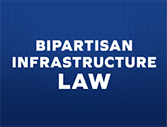Fact Sheet: Electric or Low Emitting Ferry Pilot Program

BIPARTISAN INFRASTRUCTURE LAW FACT SHEET
ELECTRIC OR LOW-EMITTING FERRY PILOT PROGRAM
| Fiscal Year | 2022 (in millions) |
2023 (in millions) |
2024 (in millions) |
2025 (in millions) |
2026 (in millions) |
|---|---|---|---|---|---|
| Electric or Low-Emitting Ferry Pilot Program |
$50 | $50 | $50 | $50 | $50 |
Program Purpose:
The Bipartisan Infrastructure Law, enacted as the Infrastructure Investment and Jobs Act, establishes an Electric or Low-Emitting Ferry Pilot Program that makes federal funding available to provide grants for the purchase of electric or low-emitting ferries and the electrification of or other reduction of emissions from existing ferries.
Statutory References:
IIJA § 71102, IIJA Division J
Program Requirements:
Funding will be allocated to projects on a competitive basis, from proposals submitted to FTA in response to Notices of Funding Opportunities.
- At least one grant shall be for a ferry service that serves the state with the largest number of marine highway system miles.
- At least one grant shall be for a bi-state ferry service with an aging fleet; and whose development of zero- and low-emission powered ferries will propose to advance the state of the technology toward increasing the range and capacity of zero emission power source ferries.
Eligible Recipients:
Will be identified in a Notice of Funding Opportunity.
Eligible Activities:
The purchase of electric or low-emitting ferry vessels that reduce emissions by using alternative fuels or on-board energy storage systems and related charging infrastructure to reduce emissions or produce zero onboard emissions under normal operation.
The use of alternative fuel means:
(A) methanol, denatured ethanol, and other alcohols
(B) a mixture containing at least 85 percent of methanol, denatured ethanol, and other alcohols by volume with gasoline or other fuels;
(C) natural gas;
(D) liquefied petroleum gas;
(E) hydrogen;
(F) fuels (except alcohol) derived from biological materials;
(G) electricity (including electricity from solar energy); and
(H) any other fuel that is not substantially petroleum and that would yield substantial energy security and environmental benefits.
